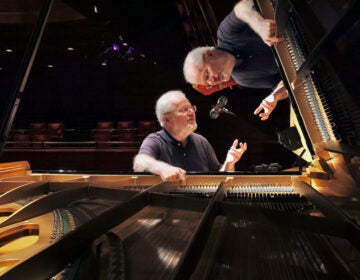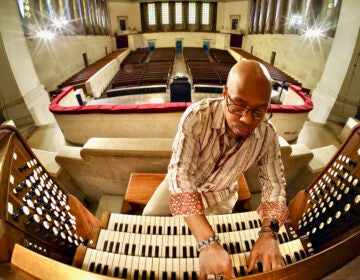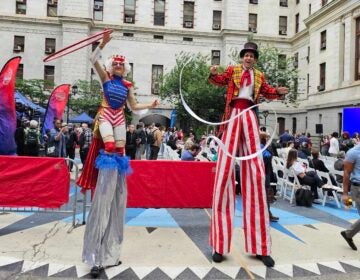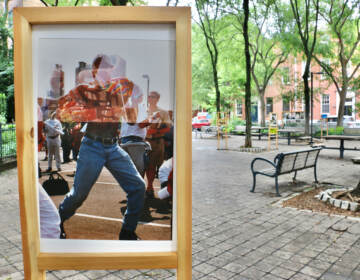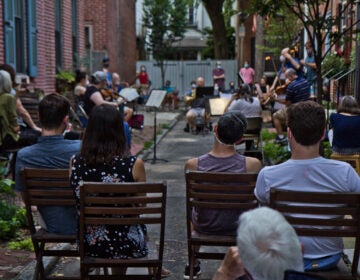Downtown Philadelphia street banners honor a historically Black ‘city within a city’
Artist Xenobia Bailey’s “Radical Black Elite” spotlights the civic strength of 18th- and 19th-century Black residents in Philadelphia.
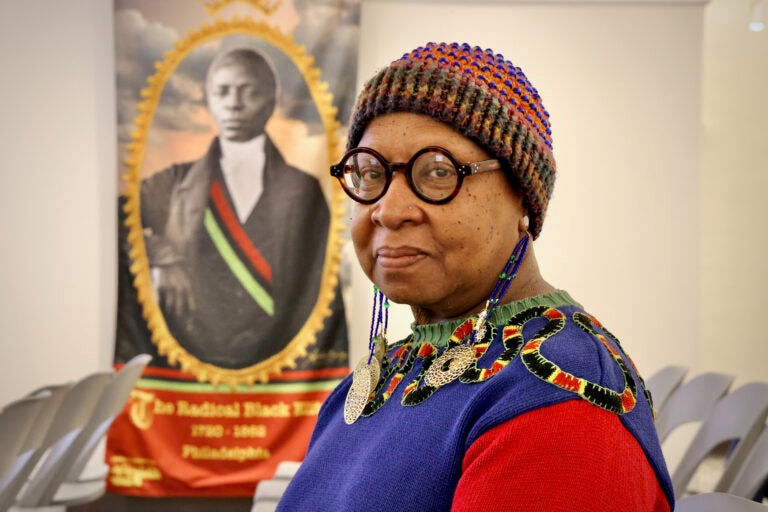
Textile artist Xenobia Bailey designed the banners that have been installed around the Pennsylvania Historical Society, celebrating ''The Radical Black Elite'' of Philadelphia from 1720 to 1862. Her presentation was a sponsored by a collaboration between the Historical Society and the Association for Public Art. (Emma Lee/WHYY)
From Philly and the Pa. suburbs to South Jersey and Delaware, what would you like WHYY News to cover? Let us know!
Street banners have appeared in Philadelphia’s Washington Square West neighborhood, centered around 13th and Locust streets, honoring Philly’s early historic Black entrepreneurs.
Commissioned from artist Xenobia Bailey by the Association for Public Art, as part of the 200th anniversary of the Historical Society of Pennsylvania, the banners represents a society of late 18th- and early 19th-century Black residents who built a self-sustaining community within the greater Philadelphia metropolis.
The banner, “The Radical Black Elite,” features an historic photograph of a well-dressed Black man circa 1840, to whom Bailey added a sash of Pan-African colors — red, black and green — framed in an oval of crocheted gold.
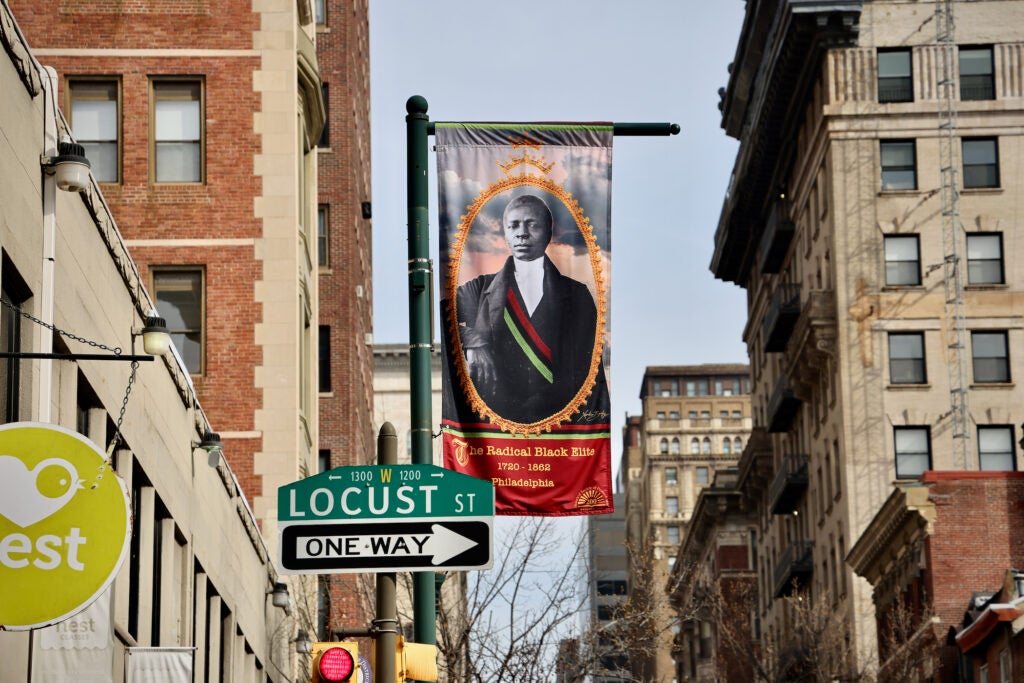
Bailey identifies the image as James Forten, the sailmaker active just after the Revolutionary War who became the richest Black man in Philadelphia of his era. He used his wealth to improve the lives of other African Americans in Philadelphia and to further abolitionist goals.
Forten acted as a gateway for Bailey to discover a Black society she had not known about.
“It connects the period of the 1700s to now, what we’re trying to do with the Black Lives Matter movement and what underserved communities are dealing with,” she said. “They were really living our dream. They were doing what we’re trying to do now.”
Bailey is a textile artist who found early success crocheting patterned hats for movies and television: Her work has appeared in Spike Lee’s “Do The Right Thing,” as well as “The Cosby Show” and its spin-off “A Different World.” She is also known for her large-scale gallery installations, “Paradise Under Reconstruction in the Aesthetic of Funk,” of which she has done several iterations.
Bailey draws on the material culture of her ancestors, mostly Texas and Oklahoma sharecroppers adept at handcraft. She recently received a grant from the Center for Craft to conduct research into Forten, a figure known mostly as a successful businessman who supported abolition causes.
But Bailey was interested in Forten as a designer.
“You could call that industrial engineering, how he redeveloped the sail,” she said. “He had a passion for sails.”
Bailey dove into records held in the Historical Society of Pennsylvania, and leaned on findings at 1838BlackMetropolis.com, where historians Morgan Lloyd and Michiko Quinones upload historical documents and design interactive explainers about the people and foundations created by the Black elite of that era.
Lloyd said Black leaders of the early 19th century developed a city within the city of Philadelphia: a community with thriving businesses that effectively governed itself and created its own social services, institutions and schools.
The Black community of that era even had its own downtown, in what is now Society Hill.
“It was a dual nationhood, in my opinion,” Lloyd said. “They were co-conspiring and communicating with free people of Southern New Jersey, New York, Delaware, all across the nation.
The name of the 1838 Black Metropolis project is derived from an 1838 census of Philadelphia’s Black population, designed and executed by the Black population, to prove the size and scope of its own demographic. The census was prepared in advance of the 1838 Pennsylvania Constitutional Convention, when lawmakers would consider extending voting rights to Black men.
The 1838 census, a copy of which is held at HSP, shows there were 18,768 documented Black residents of Philadelphia, or about 20% of the total population. There were likely more undocumented.
The 1838 census did not succeed in swaying the state Legislature to extend the right to vote — Black men continued to be denied voting rights until passage of the 15th Amendment in 1870 — but Lloyd said the census strengthened the civic power of Black residents and steeled them for future struggles.
“Especially as a few years later there will be a series of attacks that took place on this community,” Lloyd said. “There was a certain strength that was born out of it.”
Although there is some paper trail of their businesses and activities in archives, and the addresses where the community established itself can be seen in walking tours, Bailey said there is not much remaining of the stuff of their lives: the things they made and used.
Bailey is hoping to find objects of design and craft from this historic community. She’s confident it’s out there, somewhere: Sam Smith and William Whipper operated a substantial lumber company in the 19th century, supplying wood to Black carpenters; Daniel Rhodes and his wife made and sold toys according to the 1838 census; Peter Hill is the earliest known Black clockmaker in the late 18th century who ran a shop in Mount Holly, N.J. Rare examples of Hill’s tall clocks are held at the Philadelphia Museum of Art and the New Jersey State Museum.
Lloyd said many Black Philadelphia of the early 19th century were connoisseurs of finely tailored clothes, and there is an example of such at the Mother Bethel AME Church.
“Downstairs in the museum there’s a dress from that era. Historians don’t know the origin story, like who created the dress,” she said. ”If you look very closely at the material, the pleating, it’s just so beautiful and so detailed. There’s still evidence of it, you just have to search it out a little bit more.”
Bailey believes Black handcraft from free Black artisans of that time could influence Black artisans now.
“It definitely is going to change the work, because now I’ll be looking more for a material culture from this community,” said Bailey. “I haven’t found it yet, but it seems like there should be a material culture that they were designing for themselves.”
Bailey’s street banners will be on view in the streets around the Historical Society until next fall.

Saturdays just got more interesting.
WHYY is your source for fact-based, in-depth journalism and information. As a nonprofit organization, we rely on financial support from readers like you. Please give today.



